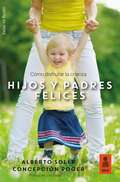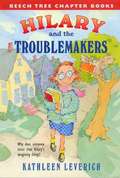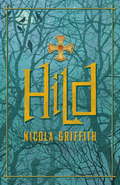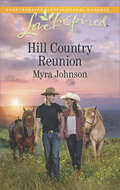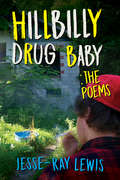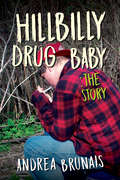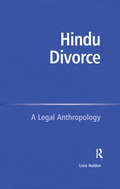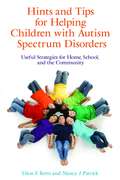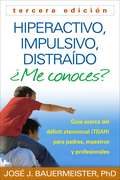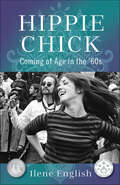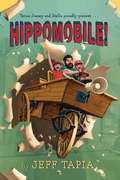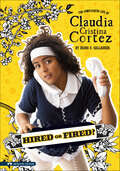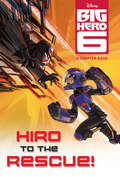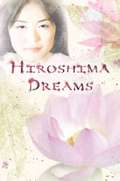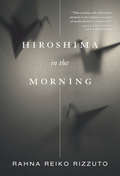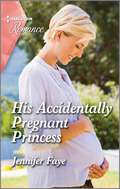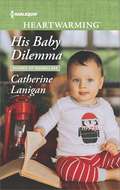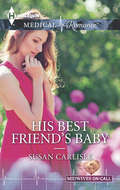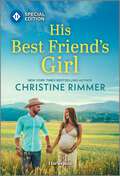- Table View
- List View
Hijos y padres felices: Cómo disfrutar la crianza
by Alberto Soler Sarrió Concepción Roger SánchezUna guía amena, didáctica y rigurosa que ayuda a entender el desarrollo de nuestros hijos en sus primeros años de vida y propone recomendaciones adaptables a cada familia. En la primera etapa de la vida de un niño su cuerpo y su cerebro se transforman a un ritmo vertiginoso. El pequeño pasa de ser un bebé que hace poco más que llorar y mamar, a ser un niño que nos pregunta por todo. ¿Qué es lo que necesita realmente un bebé?, ¿por qué llora en cuanto le soltamos?, ¿es malo que duerma con nosotros?, ¿hasta cuándo seguir con la lactancia?, ¿cómo actuar ante las rabietas?, ¿le dejamos el móvil para que se distraiga?, ¿cuándo necesita ir a la guardería?, ¿le castigamos cuando se porte mal?, ¿cómo establecemos límites? Este libro responde a estas y muchas otras preguntas, abarcando gran parte de lo que ocurre durante los primeros años de vida de nuestros hijos. Unos años que en el futuro recordaréis como vuestros mejores años.
Hike (Walden Lane)
by Evan Jacobs<p>Marlon and Steve are going camping with their dads in the rural mountain town of Dry Oak. To Marlon’s disappointment, there is no cell service at the campsite. What will he do without his phone? Marlon and Steve are playing a new video game from the creator of Clan Castles, and it’s rad. Now the online players will be ahead of him. Whatever! The trip is only for three days. Marlon helps with the tent. He goes fishing. The camp food is actually good. But he wants more adventure and excitement, so he convinces Steve to go on a night hike. There are no lights on their trail, and it’s darn cold. The boys get more than they expect when they get lost. When they spy a house in the woods, all Marlon can think of is a horror movie. And he takes off when he hears a terrifying sound, thinking his buddy is right behind him. But Steve has gone into the house! <p>Walden Lane is a quintessential small city. And these chapter books describe a typical American family, with busy schedules and the usual problems. The series explores suburban life in a fun way, with topics appropriate for younger readers. These gentle reads are innocent, hopeful, and sometimes funny, with no unsettling surprises or storylines. Each book is 5,000 words (approx.) and 10 chapters.</p>
Hilary and the Troublemakers
by Kathleen Leverich[from the back cover] A hilarious tale [in which] nobody believes a word about the mysterious characters who keep getting Hilary Hummer in trouble: A giant owl who gobbles up her homework. Snow people who threaten to tattle on her. A piggy bank who growls when Hilary tries to get her money out to buy presents... How will Hilary ever put the troublemakers in their place? Look for more books by Kathleen Leverich in the Bookshare collection including the complete Brigid series including Brigid the Bad, Brigid Beware and Brigid Bewitched, the stand alone book, The Hungry fox and the Foxy Duck and the Best Enemy series. Most pictures are described. Ages 7 and up, RL 2.5.
Hild: A Novel
by Nicola Griffith'Truly, truly remarkable' Karen Joy Fowler'Extraordinary...resonates to many of the same chords as Beowulf, the legends of King Arthur, The Lord of the Rings, and Game of Thrones' Neal Stephenson'You are a prophet and seer with the brightest mind in an age. Your blood is that of the man who should have been king ...That's what the king and his lords see. And they will kill you, one day'In seventh century Britain, a new religion is coming ashore while small kingdoms are merging, frequently and violently. Hild is the king's youngest niece, with a glittering mind and natural authority, She is destined to become one of the pivotal figures of the early Middle Ages: Saint Hilda of Whitby. But for now she has only the powerful curiosity of a child and the precarious advantage of a plotting uncle, Edwin of Northumbria, who will stop at nothing to beome king of the Angles. Hild establishes herself at her uncle's side as the king's seer, and becomes indispensable - as long as all goes well for Edwin. The stakes are high - life and death - for Hild, her family and for all those who seek the protection of this strange girl who seems to see the future. In this vivid, utterly compelling novel, Nicola Griffith has brought the Early Middle Ages to life in an extraordinary act of alchemy, transporting the reader into a mesmerising, unforgettable world.
Hill Country Reunion: A Man For Honor Hill Country Reunion The Lawman's Runaway Bride
by Myra JohnsonHope springs anew for a man and his Texas sweetheart. “Numerous heartfelt scenes combine with well-crafted characters” in the Hill Country series (RT Book Reviews).Veterinarian Tripp Willoughby returns to his hometown of Juniper Bluff knowing he has no right to ask for forgiveness. He thought keeping his Crohn’s disease a secret was the right thing to do—but he ended up breaking his college girlfriend’s heart. Now Diana Matthews has a new life running a cafe and working with animals. Reluctantly, she accepts his help with her pet therapy program. And as the furry animals bring them together, Tripp remembers how things used to be with Diana—and is convinced he must find a way to reveal the truth and win her back.
Hill Hawk Hattie
by Clara Gillow ClarkA fascinating historical novel rides the rapids of a tumultuous father-daughter relationship as the spirited young Hattie, disguised as a boy, joins her widowed pa and his rafting crew on a perilous logging voyage. Pa used to call Ma and me his girls. Now, he just says "girl," orders me around with curse words like I'm nothing. I'm not nothing, though, 'cause I feel too mean inside to be that. The year is 1883, Hattie's ma has died, and it seems that she took with her the sugar that kept Hattie and Pa sweet. Just when Hattie thinks things can't get any worse, Pa stops calling her "girl" altogether and wants her to dress as a boy and help him on his next river-rafting trip. Soon eleven-year-old Hattie finds herself alongside Pa and two other Hill Hawks - loners who live life on their own terms up in the hills - shipping logs down the dangerous Delaware. On the angry river, Hattie's pluck is sorely tested as she fields Pa's criticism, plunges over waterfalls, and tries to keep the rowdy river men from discovering her secret. Gritty and full of heart, Clara Gillow Clark's historical novel will leave readers breathless as it surges along the complex, emotional journey of a father and daughter. It's a powerful story of how death can undo a family - and how, against all likelihood, it can bind them together.
Hillbilly Drug Baby: The Poems (Hillbilly Drug Baby Ser. #1)
by Jesse-Ray LewisWhen they went to my fatherto see if he wanted to raise his twelve-year-old son he couldn’t pass the simple test of not having needles strewn all over the floor.The words are sometimes harsh and the visualizations raw, but so is reality for Jesse-Ray Lewis. He grew up in Appalachia surrounded by violence, drug dealing, and addiction.I held her for hours.There was foam at her mouth and blood as I cradled her.I am the one who closed her eyes.He entered foster care at age 12 and aged out of the system in 2016 at age 18. I thought, I want that.I want to live without walking from nowhere to nowhere.His poems rise up out of that shattered childhood as a quest for answers and a search for a new beginning. Hillbilly drug baby? Maybe that’s who I came out as. But it’s not who I want to be. In these poems, you see a young man on a precipice, wooed by drugs and forgetfulness, but longing for something bigger and better. I find a single droplet of hope and choke on it." Unafraid, he probes our deepest fears---what would it be like to live that life? To plumb the depths of hell?" - Saundra Kelley, author of Southern Appalachian Storytellers
Hillybilly Drug Baby: The Story (Hillbilly Drug Baby Ser.)
by Andrea BrunaisJesse-Ray Lewis, 19, enters a West Virginia "safe house" with few possessions beyond the kerchiefs that identify him as a gang member. An aged-out foster child, he lands in Bluefield, where a charity gives him food. What follows is the personal, dramatic story of two people who intervene in the life of a homeless, drug-abusing teen with a background of violence and neglect. In their next-door suite called the safe house, they impose three rules: "No alcohol or drugs. You have to work. You have to go to school." Jesse-Ray expresses gratitude for shelter and a middle-aged couple concerned with his welfare. But what does he want? The couple struggle to determine his true motives, especially after he admits being high on meth at their first meeting. At night he writes verse reflecting trauma and violence, shame and love, even despair. Author Andrea Brunais sees more than just a street-smart boy who can write. She sees a soul who can be saved from a downward spiral. But will Jesse-Ray accept the help of strangers, as glimmers of hope expressed in his writings suggest? Will the couple succeed in steering him toward a new life? And how will the ordeal transform everyone?
Hindu Divorce: A Legal Anthropology
by Livia HoldenThis comparative study investigates the place of Hindu divorce in the Indian legal system and considers whether it offers a way out of a matrimonial crisis situation for women. Using the narratives of the social actors involved, it poses questions about the relationship between traditional jurisdictions located in rural areas and the larger legal culture of towns and cities in India, and also in the UK and USA. The multidisciplinary approach draws on research from the social sciences, feminist and legal studies and will be of interest to students and scholars of law, anthropology and sociology.
Hints and Tips for Helping Children with Autism Spectrum Disorders: Useful Strategies for Home, School, and the Community
by Dion Betts Nancy J PatrickIf you have a child on the autism spectrum who struggles with the challenges of daily life, then this book is for you! Hints and Tips... is peppered with vignettes and stories of real-life situations and successes, and offers clever ideas for tackling everyday difficulties, such as bathing, bedtime, school trips, and selecting the right child minder. Dion E. Betts and Nancy J. Patrick provide creative, practical strategies to help parents and caregivers to support their child, and to enable their child to develop the social skills needed to manage and enjoy daily life to the fullest. The book is split into five parts: home life, hygiene, community, medical, and schools and organizations. Common problem areas are also tackled in a toolkit section, which includes checklists, 'to do' lists, visual schedules, and mnemonics to aid memory and retrieval. Hints and Tips for Helping Children with Autism Spectrum Disorders is an essential aid for parents and carers to make small and simple changes that result in big improvements in the quality of life of children, their families, and carers.
Hints on Child Training
by Henry Clay TrumbullHenry Clay Trumbull is generally considered the founder of what we know today as Sunday school. He was also a father and a grandfather. His book is filled with timeless, practical guidance for parents, presented in concise chapters. Each chapter stands alone, so the material may be read in any order.
Hiperactivo, Impulsivo, Distraído ¿Me conoces?, Tercera edición
by Russell A. Barkley José J. BauermeisterSi su hijo ha recibido un diagnóstico del trastorno por déficit de atención con hiperactividad (TDAH), usted necesita orientación y apoyo en los que pueda confiar. Ha llegado al lugar correcto. Uno de los principales expertos, el Dr. José J. Bauermeister, explica, con claridad, la naturaleza de los problemas de atención y las razones por las que los niños con estos trastornos actúan como lo hacen. Usted aprenderá estrategias cuya eficacia ha sido comprobada para superar los frustrantes problemas de la conducta, para ayudar a su hijo a tener éxito en la escuela y, de ser necesario, para encontrar la ayuda profesional adecuada. El Dr. Bauermeister ha dedicado su carrera a trabajar con niños hispanos y con familias hispanas cuyas experiencias y culturas distintivas se reflejan en cada página. Escrito en español (no traducido), este libro es un recurso único para ayudarlo(a) a usted a satisfacer las necesidades de su hijo. Además, proporciona información esencial para maestros y otros profesionales. Esta tercera edición, revisada y actualizada, incluye la investigación científica y las estrategias de tratamiento más recientes. If your child has been diagnosed with attention-deficit/hyperactivity disorder (ADHD), you need guidance and support that you can trust. You've come to the right place. Leading expert Dr. José J. Bauermeister clearly explains the nature of attention problems and why children with these disorders act the way they do. You'll learn proven strategies for overcoming frustrating behavior problems, helping your son or daughter succeed in school, and, if needed, finding the right professional help. Dr. Bauermeister has devoted his career to working with Hispanic children and families, whose unique experiences and culture are reflected on every page. Written in Spanish (not a translation), this is a unique resource to help you meet the needs of your child. It also provides essential information for teachers and other professionals. Revised and updated, the third edition includes the latest scientific research and treatment strategies.
Hippie Chick: Coming of Age in the '60s
by Ilene EnglishIn Hippie Chick, a rebellious teenager finds her mother dead in the bathroom. To save her from living alone with a difficult father, her older sister sends her a one-way plane ticket to leave New Jersey. Landing in San Francisco, she is thrust into a lifestyle way beyond what she is ready for, and that challenges all previous notions of how one behaves. It is 1963, and we are brought along as Ilene becomes immersed in the unfolding of the sixties during the earliest days of sexual freedom, psychedelic drugs, the jazz scene, and rock ’n’ roll. This is a deeply personal story of how one young woman manages to survive and even to thrive in the face of the whirlwind of experiences coming at her. It is filled with a rich tapestry of moments that run the gamut from the sublime to the ridiculous, and everything in between.
Hippomobile!
by Jeff TapiaThere are many stories about kid crusaders who save something, but none like this one. With steampunk, tall tale, and just plain silly elements, the story of how ten-year-old twins Jimmy and Stella found out about the unique vehicle called the hippomobile, learned its history, and then used it to rescue their beloved town of Wymore is an original variant on a tried and true theme. A cast of wildly eccentric characters, most of whom are the twins' forty-seven grandmas and grandpas; a liberal sprinkling of diner slang and odd colloquial phrases, many explained in footnotes; and a sense that the events described never took place but could have are among the surprising ingredients of this unconventional creation. The fact that there really was a hippomobile with its own history doesn't interfere with the fun.
Hired or Fired? (The Complicated Life of Claudia Cristina Cortez)
by Diana GallagherAll the seventh graders have to find jobs for Work Week. Claudia's job should be a piece of cake, but starting on day one, she feels like she's messing up. Can she figure out how to keep her job, or will Claudia be the first person ever to fail Work Week?
Hiro to the Rescue! (Disney Big Hero 6)
by Disney PressBig Hero 6 features brilliant robotics prodigy Hiro Hamada, who finds himself in the grips of a criminal plot that threatens to destroy the fast-paced, high-tech city of San Fransokyo. With the help of his closest companion—a robot named Baymax—Hiro joins forces with a reluctant team of first-time crime fighters on a mission to save their city. Boys ages 6 to 9 will love this chapter book based on the film!
Hiroshima Bomb Money
by Terry WatadaThrough the lives of three siblings living in Hiroshima, Japan, Terry Watada explores the sweep of history during the years 1930 to 1945. The youngest, Chisato Akamatsu, travels to Canada looking for a new life but is confronted by the brutalities of immigration, a troubled marriage and the humiliation of the Japanese internment by the Canadian government. Hideki, the only brother, joins the military to fight for the Emperor and find “glory” in China, but finds only the fallacy of patriotism, the brutality of war, and the futility of existence. Chiemi, the oldest, was in the city when to the atom bomb hit. The three encapsulate the hopes, fears, dreams, the inhumanity of the period and resiliency of humans caught in historic events. In his fourth novel, Canadian poet, dramatist, and novelist Terry Watada delves into the Pacific War, looking at WWII from a Japanese perspective, unique in Canadian literature.
Hiroshima Dreams
by Kelly EastonLin can't explain the knowledge she has of the future, of what people will say or what will happen. It's a gift she shares with Obaachan, her grandmother, who has recently come from Japan to live with Lin's family. But seeing the future is more than knowing whether or not a boy will call. What is Lin to make of the visions she has of a day long ago, when the atomic bomb was dropped on Hiroshima? Acclaimed author Kelly Easton's poignant coming-of-age novel about a girl with psychic abilities is rich in imagery and memorable characters.
Hiroshima in the Morning
by Rahna Reiko RizzutoThe award–winning author of Shadow Child embarks on a simple journey to record history that changes her life as a wife and mother.In June 2001, Rahna Reiko Rizzuto went to Hiroshima, Japan, in search of a deeper understanding of her war-torn heritage. She planned to spend six months there, interviewing the few remaining survivors of the atomic bomb. A mother of two young boys, she was encouraged to go by her husband, who quickly became disenchanted by her absence.It is her first solo life adventure, immediately exhilarating for her, but her research starts off badly. Interviews with the hibakusha feel rehearsed, and the survivors reveal little beyond published accounts. Then the attacks on September 11 change everything. The survivors' carefully constructed memories are shattered, causing them to relive their agonizing experiences and to open up to Rizzuto in astonishing ways.Separated from family and country while the world seems to fall apart, Rizzuto's marriage begins to crumble as she wrestles with her ambivalence about being a wife and mother. Woven into the story of her own awakening are the stories of Hiroshima in the survivors' own words. The parallel narratives explore the role of memory in our lives and show how memory is not history but a story we tell ourselves to explain who we are.2010 FINALIST FOR THE NATIONAL BOOK CRITICS CIRCLE AWARD&“A brave compassionate, and heart-wrenching memoir, of one woman&’s quest to redeem the past while learning to live fully in the present.&”—Kate Moses, author of Wintering"This searing and redemptive memoir is an explosive account of motherhood reconstructed.&”—Ayelet Waldman, author of Red Hook Road
His Accidental Countess: A Regency Cinderella Story (Mills And Boon Historical Ser.)
by Annie BurrowsFrom abducted……to betrothed!To stop an unsuitable elopement, Tobias Spenlow bundles his ward’s intended bride into his carriage—only to discover he’s made a terrible mistake. The woman is actually innocent governess Miss Dorothy Phillips—whose reputation he’s unintentionally ruined! The only way to right this wrong is for the earl to wed her. She might have accidentally become his countess, but their consuming attraction has him courting her in earnest!From Harlequin Historical: Your romantic escape to the past.
His Accidental Heir: A passionate story of scandal, pregnancy and romance
by Joanne RockThe Boss's Baby Bargain When resort developer Cameron McNeill goes undercover to root out problems at his prized island property, his first discovery is the irresistible concierge, Maresa Delphine. Her business smarts are vital to his mission. But the struggling single mom could help with his personal mission, too: fulfilling the marriage terms of his grandfather's will. Maresa is overwhelmed caring for her infant niece and tending to the demands of the resort's sexy mystery guest. When he reveals himself as the owner, she's thrown for a loop. But when he proposes...can she resist his brand of trouble in paradise?
His Accidentally Pregnant Princess (Princesses of Rydiania #1)
by Jennifer FayeIn the latest Harlequin Romance by Jennifer Faye, the CEO is in for two shocking surprises when the princess regains her memory… The CEO, his housekeeper…and her double confession! When CEO Antoine meets a stranger in need, he offers her work and refuge as his temporary housekeeper. Their mutual attraction is intensely distracting, yet Antoine knows he should resist the woman who&’s lost her memory. But when they give in to their undeniable desire, Antoine is faced with shocking consequences… Because Cecelia is actually a princess—and now she&’s accidentally pregnant!From Harlequin Romance: Be swept away by glamorous and heartfelt love stories.Princesses of RydianiaBook 1: His Accidentally Pregnant PrincessBook 2: Royal Mom for the Duke's Daughter
His Baby Dilemma
by Catherine LaniganMust they always be continents apart?Nobody expects Paris fashion designer Grace Railton to settle down in her Indiana town, least of all Mica Barzonni. Fifteen months ago, he turned to her for comfort and compassion following a farming accident that left him permanently injured. Then she returned to France and went silent on him.Until, suddenly, Grace shows up on his doorstep with life-altering news. Mica, a father? He’s barely learned to navigate his postaccident life. But this could be his chance to become the man he’s always wanted to be—the husband and father Grace and their baby son need. Now Mica just has to convince her to stay.
His Best Friend's Baby (Midwives On-Call #6)
by Susan CarlislePregnant on his doorstep! Former army medic Ryan Matthews loves his work as a midwife-bringing life into the world helps him forget losing his best friend in Iraq. But when Ryan finds his friend's pregnant wife on his doorstep, his whole world is turned upside down... For Ryan, opening his door to Phoebe is one thing-but opening his heart is a whole different matter. Until one scorching, unforgettable kiss unleashes emotions he locked away long ago...and Ryan finds himself fighting against a love he's never dared to believe exists!
His Best Friend's Girl (Bravo Family Ties)
by Christine RimmerTrue love might be patient…but how long is too long? Ethan Bravo had been in love with Matilda Hunt since…well, since before she was Matilda Hunt, actually. Because he and Gabe Hunt had been best friends since high school. So Matty was off-limits to Ethan. Even now, after Matty has been a widow for three years, he considers her forbidden fruit. It was easy when she lived in LA, but now Matty&’s moved home for good. And instead of betraying his best friend&’s memory and revealing his heart, Ethan settled for being her confidant. Except Matty is pregnant with the child from her now ex-boyfriend—a man who wants nothing to do with Matty or the baby. So Ethan is stepping up, becoming the one man Matty can trust. Sharing his true feelings now would shatter that trust. And Ethan can&’t risk losing Matty—again. He can be the one man she deserves, even if keeping his secret could break his heart. From Harlequin Special Edition: Believe in love. Overcome obstacles. Find happiness.Bravo Family TiesBook 1: Fifty Ways To Say I'm PregnantBook 2: Marrying MollyBook 3: Lori's Little SecretBook 4: Bravo UnwrappedBook 5: The Bravo Family WayBook 6: Married in HasteBook 7: From Here to PaternityBook 8: A Bravo Christmas ReunionBook 9: Valentine's Secret ChildBook 10: Having Tanner Bravo's BabyBook 11: The Stranger and Tessa JonesBook 12: The Bravo BachelorBook 13: A Bravo's HonorBook 14: Valentine BrideBook 15: A Bride for Jericho BravoBook 16: Expecting the Boss's BabyBook 17: Donovan's ChildBook 18: Marriage, Bravo Style!Book 19: A Bravo HomecomingBook 20: The Return of Bowie BravoBook 21: Hometown ReunionBook 22: Taking the Long Way HomeBook 23: Her Best Friend's WeddingBook 24: When Christmas ComesBook 25: His Best Friend's Girl
